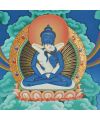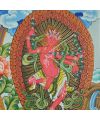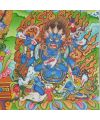Guhyasamaja Thangka Painting – 32.5”x23”
Availability: In stock
SKU:
TH761768096062
$900.00
Guhyasamaja represent is one of the most important tantric deity of esoteric practice in Gelug tradition. The practice of Guhyasamaja is of significance for the Gelugpa school of Tibetan Buddhism and to the Lineage of the Dalai Lamas. This Guhyasamaja thangka beautifully painted by our master artisan in Nepal.
Guhyasamaja eans "Secret Union" or "Assembly of the Secret Ones (Tib. Sangwa-dupa). Guhyasamaja is also know as "King of Tantras".
In Tibet, Guhyasamaja is particularly favored by the Geluk Order, most likely for the antiquity of his texts. Translated in the 8th century, the Guhyasamaja Tantra was one of te first Sanskrit works to be translated into Tibetan. One tradition has it that Shakyamuni Buddha himself proclaimed the tantra the morning after his enlightenment. Other traditions claimed tat Maitreya taught the tantra in the Tushita Heaven, and that the Indian scholar Asanga brought it to the human world in the 4th century. Like other deities of the Unexcelled Yoga tantra tradition, Guhyasamaja is associated with the Buddha Akshobhya. Many texts, including the Guhyasamaja Tantra itself, simply call him Akshobhya or Akshobhyavajara. Guhyasamajas is dark blue in color. He has three faces: the central one is blue and fierce, the right face is peaceful white; and the left one is red. He is considered Lord of the Diamond Body, Speech, and Mid of All the Thatagatas. He gently holds his consort, Sparshavajra, in a intimate embrace. The goddess has six hands and three faces, and is "like her consort," in the words of an early ritual. Sparshvajra gazes upward in rapture, meeting Guhyasamaja´s downward glance. The goddess protects an energy and ferocity that contrasts with the serene countenance of her mate. Being "of the same nature," the divine pair possess similar hand implements. The central pair of hands hold, right and left, a vajra cepter and a bell, the upper pair, a wheel and a blazing jewel; the lower pair, a lotus and a sword. The vajra cepter and the bell symbolize, among other things, the vajra Buddha clan of Akshobhya. The wheel symbolizes the mirror wisdom clan of Vairochana, the lotus the discriminating wisdom clan of Amitabha, the jewel the equality wisdom clan of Ratnasambhava, and the sowrd the all- accomplishing wisdom clan of Amogasiddhi. Thus Guhyasamaja Budha symbolically represents the union of all the Buddha clans.
Dimension: With Border: 32.5" Long x 23" Wide
Without Border: 30 Long x 20" Wide
Weight: 0.5 kg
Material: Cotton Canvas, Paint, and 24 K Gold.
Origin: Nepal
Painted: This wonderful high-quality traditional Guhyasamaja thangka Painting is painted by the experienced artists.
Availability: This traditional Guhyasamaja thangka Painting is shipped within 12 hours of order received through Express courier and delivery to the customer within 5 to 7 business days after it is shipped and Insurance is included in the shipping cost.
Note: Please note that the actual colors of this traditional Guhyasamaja thangka may vary due to differences in monitor color depth and make. The color shown is as close as possible to the actual colors of the Thangka Painting.
Write Your Own Review














